January 2011 Newsletter
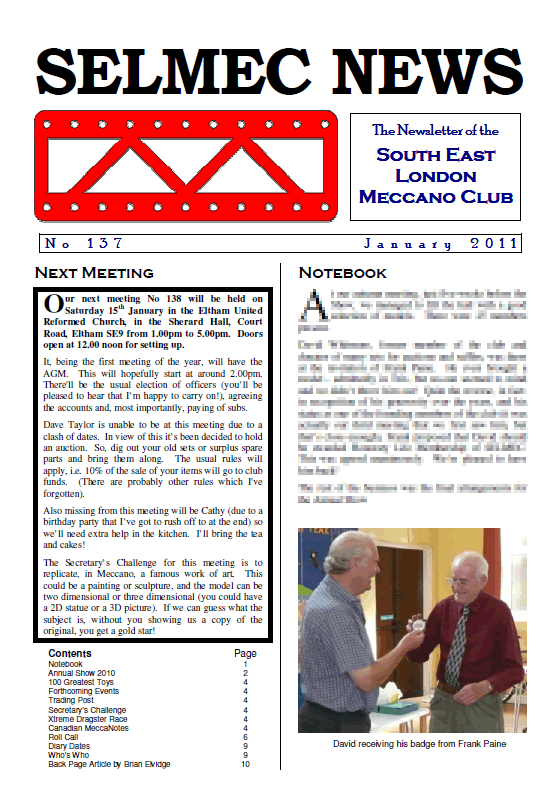
January 2011 Newsletter
Issue 137
Report written by Chris Warrell
Our annual event, billed for the first time as a Show rather than an Exhibition, proved to be another fantastic day.
Once again the hall was packed with models from, not only our own members, but a number of visiting exhibitors. We made use of three new circular tables that the hall now has and, together with a number of tables brought by members we were able to just about fit everyone in. We might have to hire a third room next year! Luckily the Russian language class only required a few of the small tables, so weren’t too deprived this time.
Tim Surtell had bought some new advertising banners. One of these had been tied to the church’s own board since the previous Monday, advertising the Show as being on ‘Next Saturday’, this being substituted on the morning by a similar banner with ‘Today’ in its place.
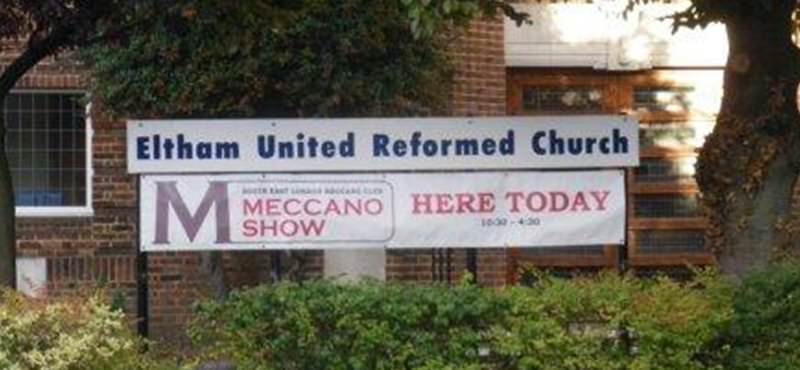
Our new banner outside Eltham URC
Tim had also produced a Meccano version of the new Show logo (seen on all the posters and the new banners) and this was the first sight to greet the visitors after entering the building.
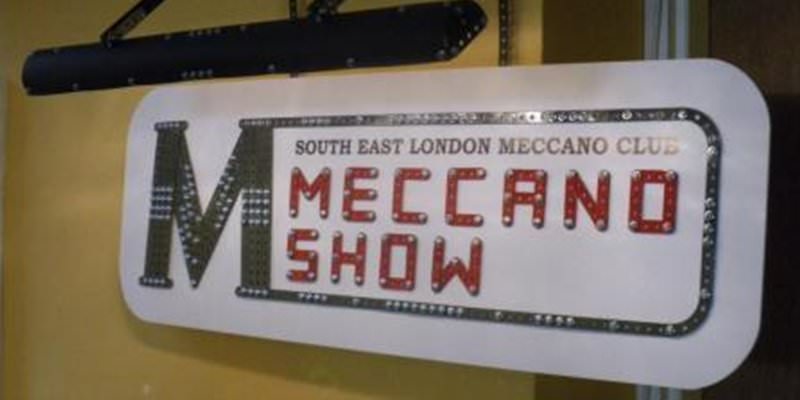
Tim Surtell’s illuminated show logo
As usual, we had a good mix of large and small models on show with Ralph and Sue Laughton’s Eiffel Tower and James Plicio’s fairground ride dominating the main hall. In the refreshments room we expanded the number of exhibitors to six with Alan Wenbourne’s London Eye in one corner and Allen Berman’s giant crane in the other. To add a bit of variety John Gay was in the same room with a 00 gauge model railway layout. At the other end of the scale we had both Geoff Carter and Douglas Windibank turn up by public transport, each with a suitcase crammed full of small models.
Although it seemed to me that we had more visitors than last year the ticket count showed that it was about the same with 283. It was very busy all day, and we even had several people waiting to go in soon after 10.00am — half an hour early. Our advertising (which is all free by the way) certainly paid off along with all those summer activities that we’ve attended.
We also had a decent plug in the News Shopper and Mercury free newspapers. The Mercury sent a reporter and a picture and caption appeared on the front page of the following week’s edition.
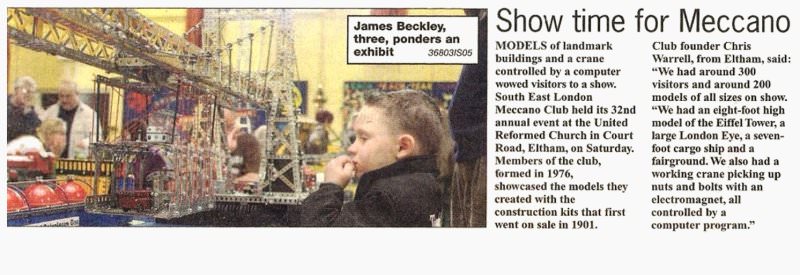
Mercury article
As is now usual we held a raffle and there were a good selection of quality prizes, mostly donated by members, so thanks are due to all of them.
Thanks are also due to all those of you who helped with the setting up and clearing away of the hall, tying up posters etc, and filling the various slots of the rotas, especially Greg Clarke who didn’t have a model but turned up anyway and generally helped out. Peter Clay needs special thanks for making sure that the various rotas were filled and spending all that time at the end, when most of us are hastily packing our models away, counting all the money and double checking the ticket numbers against income.
One of the highlights, as always, was a visit to the refreshment table. There was a good selection of food, masterminded by Frank Paine who made the rolls and brought various other items along, as did some members. Cathy Warrell made a number of cakes and was in charge of the serving of food, assisted this year by Cathy Claydon and Lucy Warrell.
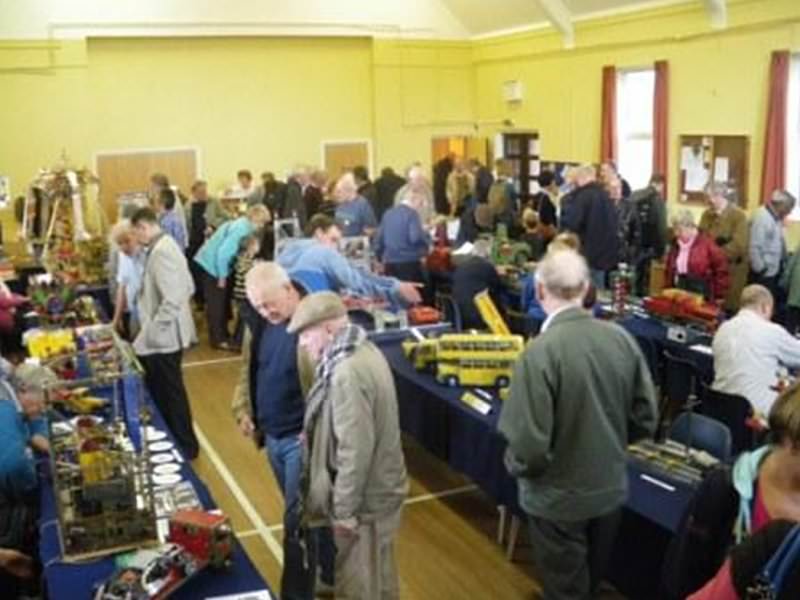
A general view of the show
Models on Display
Jim Arthur — Ferris wheel; Revenge-class battleship; Field gun.
Adrian Ashford — 2–6–0 locomotive; Excavator; Sports car; Tractor and trailer; Roman chariot.
Allen Berman — ‘Meccego’ (Meccano and Lego) SML 35 level luffing crane with electromagnet and full autonomous control by Lego Mindstorms NXT robotics system.
Geoff Carter — The only ‘new’ model was the Big Wheel, from Bernard Périer’s new book Serial Constructor; Also other Périer models: Archie (the caterpillar soldier), the ‘dodgy’ robot butler (used on the exhibition flyer) and Jog Dog; Bugatti; Boeing Sea Knight twin helicopter; RR Silver Ghost; Bates 1918 tractor; ‘Scooter de Livraison’, from a French Meccano Magazine; Manual models: Helicopter, from the Anniversary crane set; Racing bike, from the ‘Dynamic’ bike set: Seaplane, from the ‘Collection’ aeroplane set: Go-cart, from the ‘Design Advanced’ racing car set: Scooter and digger, from M&S 1-model sets.
Peter Clay — Spiralograph designing machine producing designs which spiral towards the centre; ‘Camionette’ lorry; ‘Editions’ set motorbike; Several small novelty models and mechanisms from Constructor Quarterly; Working magnifying glass with ‘pinhole’ lens; ‘Black hole in space’ — light can get in but not out, leaving a visible black hole; Two-stage epicyclic reduction gearing giving 56 x 56 ratio using 56 & 57 teeth gears; extending ram designed by Chris Fry using scrolling left- and right-handed worms and 19/20 teeth pinions.
Cathy Claydon — Army recovery tractor.
Andrew Couzens — Small roundabout with horses; Rear entrance double decker bus; Eight wheel tipper truck; American car based on model from a № 9 set manual.
John Cowdery — Blue/gold 1920s lorry; Three robots; Small digger; Small racing car; Three aircraft; Scooter; Pneumatic drill with man; Cycle; Exercise machine; Stationary boiler; Bedford lorry; Leyland lorry; Flowers with caterpillars; Housefly.
Hanef Degia — Two-car Ferris wheel driven by a gas steam engine.
Ivor Ellard — Transporter bridge.
Brian Elvidge — 1:16 scale railway.
George Foard — Three amusement models; Périer penny farthing; Tracked back-hoe from set using two Bowden cables for jib movement; 17 simplicity/nano models from early 1920s to present day.
Chris Fry — Triumph TR6A; MIG21; Small excavator; Mercedes racer; Motorcycle; Trike; Small F1 car; Biplane; F1 car based on mechanical workshop model; MG sports car.
John Gay — Hornby Dublo OO gauge 3-rail layout from the 1950s; Showman’s road locomotive in red and green; 84-key Gavioli organ.
Simon Greatrex — Mamod workshop.
Stuart Jones — Low loader; Clockwork propeller driven car; Dragster from kit.
Ralph and Sue Laughton — № 10 set Eiffel Tower; Rope climber; Nano roundabout; ‘T’ form Meccanograph.
Brian Leach — № 10 set cargo ship; Plate and strip bender; Dragon illusion; 3 speed automatic gearbox.
Stan Leach (visitor from the North East London Meccano Club) — Jones KL66 mobile crane.
Frank Paine — Pre-war design Eiffel Tower, dealer’s display Tower Bridge; Royal Sovereign battleship; Dockside Crane; Dealer’s display Stephenson’s Rocket; Aero Constructor biplane; Small seaplane; Racing car; ‘Schools’ class locomotive; Traction engine; Fairground Big Wheel (the last three being push-button operated). There was also a range of vintage Meccano outfits dating from 1913 to the 1950s.
Keith Patey — Furnace charging machine, based on model 9.23 in the 1951 instruction manual.
Ivor Perrett (visitor from Runnymede Meccano Guild) — Wurlitzer theatre organ.
Santiago Plicio — Storm rider fairground ride; Rockafella dancing robot.
Andrew Prentis — Trebuchet; 1/5th scale Land Rover series II.
Eric Smith — Two trams running on twin 3’ long tracks modified from last year.
Tim Surtell — 2010 Meccano Show sign.
David Tracy (visitor from Runnymede Meccano Guild) — A lorry and trailer from the 1949 № 9 set instruction book. It was powered by a clockwork motor and included a two-speed gearbox. On it was a car, built from the Mechanical Workshop set from 2007.
Chris Warrell — Royal Victoria Dock bridge; Three blue/gold ships; Drum kit; Three wheel car; Dragster.
Dick Watson (visitor from North West Meccano Guild) — Plastic Meccanograph from the 400 set.
Alan Wenbourne — Mini London Eye.
David Whitmore — Hispano-Suiza aeroplane engine Type 12V; Trix Bugatti.
Douglas Windibank — Space 2501 Federation Protector and blast deflector; Apollo space rocket; Two lunar landing models; Two small robots; Crazy Inventor seabed walker; Foden steam lorry powered by Magic motor; Motor bikes; Everglades hovercraft; Lorry; Six-wheeled troop carrier; Two small motorcars; Red Arrows jet plane; Garden swing; Spanners seat; 1930s roundabout; Small biplane; Station tractor; Field gun; Windmill; Four-wheeled vehicle.
This was one of our informal quarterly meetings where our members showed off their latest Meccano creations.
At around 2:00pm we had a short committee meeting, followed by the Model Tour in which members were invited to give a short talk about their models — in particular their entries for the Secretary’s Challenge!
Written by Brian Elvidge
This model is a 1:16 scale 3½” gauge railway all built from Meccano or compatible parts. There are some non-Meccano items like the wiring, the locomotive’s current collector, and a few other parts.

Industrial railway
Track
This is eight feet in length, formed of pairs of angle girders, with angle girders as sleepers. At each end of the run there is a typical buffer stop, also made of Meccano parts. Offset to one side is a conductor rail (or ‘juice rail’ in railway slang) between the rails, also formed of angle girders, with strengthening strips bolted on. This is insulated from the running rails by insulating spacers specially made for this project by Mr. S. R. Borrill of Skegness, due to the poor availability of the Meccano Elektrikit part and their poor quality construction.
Each track joint is reinforced to ensure the track is rigid and to ensure reliability in operation. A track nominal voltage of 12–20V DC is carried.
Rolling Stock
Due to the availability of parts held, I built only three items of rolling stock: a typical 16 ton mineral wagon of which there were thousands on British Railways, a 12 ton ballast wagon again typical of BR vehicles, and a brake van.
The two wagons have been taken from The Bradley Files edited by Philip Webb in 2010, published by the International Society of Meccanomen and available from MW Mail Order. Both these vehicles were displayed by the late Phil Bradley, President of the Holy Trinity Meccano Club, at various meetings of theirs in the mid 1970s. They have been rebuilt in current yellow/blue and zinc finished parts of the 1970s and 1990s French eras, with slight changes in the construction. Both have operating brakes and either drop sides or doors for off-loading cargoes.
The brake van is based on the L. M. S. 20 ton one immortalised in the Hornby-Dublo range. It is 15½” long with wheel flanges and face plates as wheels, working clasp brakes, foot boards and guard’s accommodation.
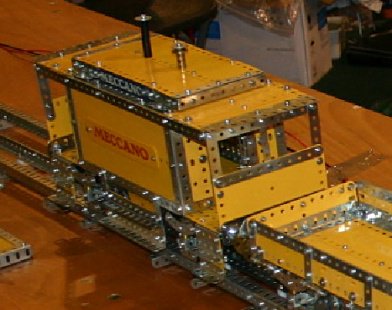
Brake van
All the rolling stock can be pulled or pushed by the locomotive described below.
Industrial Diesel Locomotive
This is loosely based upon a Yorkshire Engine Company or Brush Traction design of four wheel diesel electric or hydraulic locomotive used for industrial purposes in steel plants or chemical works and exported world-wide. It is powered by 12–15V DC 540 type electric motor geared to one axle by reduction gears; the other axle is powered by coupling rods, which necessitates accurate quartering of the driving wheels, which are face plates and wheel flanges.
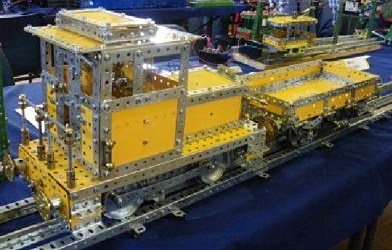
Locomotive
Between the wheels the locomotive picks up the power from a shoe formed by a spring loaded brass strip. This was found to work best. This locomotive will haul or push all the above wagons with ease. The locomotive has detailed brake gear, end handrails, safe refuges for cab entry and shutter access.
Editor’s note: Appropriately, Brian won the Phil Bradley Cup for his model at the Holy Trinity Meccano Club.